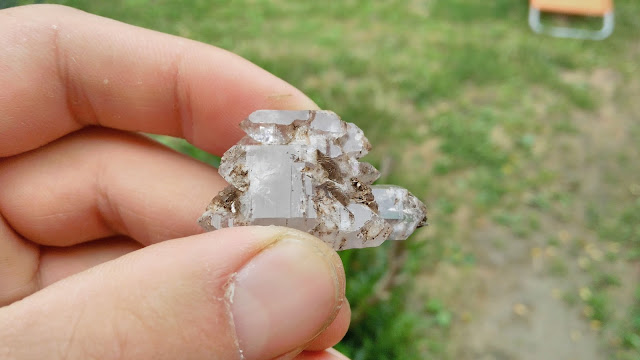A most következő két poszttal megmutatjuk nektek, hogy nem csak a magasság, a mélység sem tántoríthat el minket egy jó kis kalandtól. Lehetőségünk nyílott ugyanis részt venni a Magyar Karszt és Barlangkutató Társaság montenegrói barlangi expedícióján. Ez az expedíció évente kerül megrendezésre, augusztus első heteiben, számos magyarországi és külföldi csapat részvételével, célja a környék barlangjainak felkutatása, bejárása, és dokumentálása.
With
our next two posts we'll try to show you that neither height, nor depth
can scare us from having some fun! We had the opportunity to join the
Hungarian Speleological Society's cave expedition in Montenegro. This
expedition is organized annually, takes place in the first two weeks of
August since 2003. Numerous Hungarian and international teams
participate every year. The aim of the expedition is to discover,
explore and document the caves ot the area.
Ereszkedés - The descent
(Fotó: Lukács Kata)
A tábor Njegusi falu mellett bújt meg, egy pár töbör között,
a környéken ritka kincsnek számító apró sík részen. A Njegusi-polje a
Kotori-öböltől kb 10 km-re keletre fekszik, a Dinári-hegység karsztosodott mészkőcsúcsai
közt, 850-1400 méteres magasságban.
The
Camp was located near Njegusi, on a treasured small flatland among the
slopes. The Njegusi polje lies 10 kms East of the bay of Kotor, nested
at the height of 850-1400 metres among the most karstified ridges of the
Dinarides.
A környék - The "neighborhood"
(Fotó - Sárközy Ádám)
A tábor - The camp
(Fotó - Sági Bence)
Itt található a legmélyebb, magyarok által feltárt barlang,
a 715 méter mély, és 7,5 km hosszú Kétlyukú-Jeges barlangrendszer. A, magashegyi típusú barlangokban,
ellentétben a budai termálvizes barlangjaink labirintusszerű járataival, szűk
meanderező részek váltakoznak több tíz méteres aknákkal.Tavaly került
felfedezésre a kb 400 méter mélységben nyíló, 30 m átmérőjű, 312 m mély
Hubertus akna. Az érzékeltetés kedvéért, kb olyan mély, hogy az Eiffel-torony
alig 10 méter híján eltűnne benne. Mindezt olyan mélyen, hogy ennek az egésznek
a tetejére még mindig elférne a chicagoi Sears-torony, és épp csak karcolná a
felszínt.
The deepest cave discovered and explored by Hungarians is located here. It is the Kétlyukú-Jeges cave system, (Ledena
pećina) which is 715 metres deep and 7,5 kms long. In the alpine
cavetypes, as opposed to the labyrinth-like thermal caves of Buda,
narrow meandering parts alternate with shafts measuring tens of metres. The
Hubertus shaft has been discovered last year. Opening at the depth of
400 metres from the surface, it is 300 metres deep, and 30 metres
across. Just for comparison if one would stuff the Eiffel tower in this
shaft, only 10 metres would be visible from the top. At a depth that the
Sears tower of Chicago would still fit atop it, and would barely
scratch the surface.
Hubertus-akna - Hubertus shaft
(Fotó - Berentés Ágnes)
Az expedíció résztvevői 4-6 fős csoportokra osztódtak, és
különböző feladatokat láttak el egy-egy barlangnál.
The crew of the expedition were divided into groups of 4-6 and given their respective tasks in different caves.
A csapat - The crew
(Fotó - Sárközy Ádám)
Voltak csapatok, akik a felszínen kerestek új
barlangnyílásokat, ami a karrmezőn nem is olyan ritkaság. Ha megvolt az
ígéretes barlangkezdemény, jött egy beszerlő csapat, akiknek az volt a
feladata, hogy kiépítse a barlang bejárásához elengedhetetlen kötélpályát, és
egyben pionírként fel is derítse azt, amíg lehetősége van.
Some
teams looked for new caves on the surface, and there were quite a few
around on the karst fields. If they found something promising enough,
the ropetrack team comes in, and sets up the ropes necessary for
exploring the cave, and start pioneering the exploration to so long as
it is possible.
Piros, leereszkedik a kéményen, és mégsem Mikulás - Red, goes down shafts, yet it's not Santa
(Fotó - Sárközy Ádám)
Utánuk jöhetnek a fotós csapat tagjai, akik fényképanyaggal
járulnak hozzá a barlang dokumentációjához. (S akiknek a végén a leghálásabb
mindenki, mert tőlük lesz kép a blogra)
Végül a sort a térképezős csapatok zárják, akik hosszasan
ücsörögve rajzolják fel a barlang hossz és keresztmetszetét, hogy a táborban pihengető nagyöregek is képet kaphassanak a földmély dolgairól.
After the first teams the photographers' team is
launched. They are the ones who supplement the photographic
documentation of the caves. (And to whom we are most grateful after all,
because they present us with pictures for the blog)
The
last of the teams are the cartographers, who sit around endlessly while
they draw the cross- and longitudinal-sections of the cave, so that the
seasoned old cavers back at the camp, who are not active anymore can
get a picture about what lies beneath.
(Fotó - Lukács Kata)
Eközben a felszínen bevetésre készen vár az ügyelet, aki
szükség esetén elindítja a Barlangi Mentőszolgálat helyszínen lévő tagjait,
valamint külön említést érdemelnek a barlangba nem járó, de kulcsfontosságú
családtagok, tapasztalt öregek, és egyéb tábori népek, akik napi szinten egyben
tartják a tábort.
Meanwhile
the cave rescue team was steady in the camp just in case. And last but
not least we have to mention the people who, although did not descend
with us, but who kept the camp together: family members and the old
cavers.
A
következő posztban bemutatjuk nektek a Bogos-barlang feltárását. Olyan
helyekről láthattok képeket, ahol kevesebben jártak, mint a világűrben!
Előttünk csak az Adrenalin Barlangkutató Egyesület tagjai jártak ott,
akik a barlang megtalálói, de összességében így sem volt lent több, mint
15 ember a 7 milliárdból!
In
the next post we'll introduce you the exploration of the Bogos-cave.
You'll be able to see pictures from places where fewer people have set
foot than in outer space! Only the discoverers of the cave, the
Adrenalin Speleological Society members preceded us, but the total count
still does not exceed 15, out of the 7 billion!
Addig is
Until then


















































